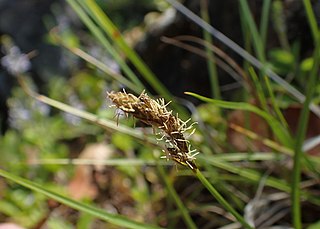
The Cyperaceae are a family of graminoid (grass-like), monocotyledonous flowering plants known as sedges. The family is large, with some 5,500 known species described in about 90 genera, the largest being the "true sedges" genus Carex with over 2,000 species.
Carex preissii is a flowering plant in the sedge family, Cyperaceae, that is native to Western Australia.

Carex hostiana, the tawny sedge, is a species of flowering plant in the genus Carex, native to Europe and northeast Canada, and extinct in Massachusetts. It is a member of the Carex flava species complex.

Carex baccans, the crimson-seeded sedge, is a species of flowering plant in the family Cyperaceae, with a widespread distribution in subtropical and tropical Asia; most of the Indian Subcontinent, southern China, most of Malesia, and on to New Guinea. An endophytic bacteria species, Glycomyces endophyticus, has been isolated from its roots.
Carex caespititia is a tussock-forming species of perennial sedge in the family Cyperaceae. It is native to parts of Asia from Assam in northern India in the west to central China in the east.
Carex cirrhulosa is a tussock-forming species of perennial sedge in the family Cyperaceae. It is native to parts of the Philippines.
Carex cardiolepis is a tussock-forming species of perennial sedge in the family Cyperaceae. It is native to parts of Asia, from Afghanistan in the west to south central parts of China in the east.
Carex condensata is a tussock-forming species of perennial sedge in the family Cyperaceae. It is native to parts of Asia, from the eastern Himalayas in the north west to Thailand in the south east.

Carex cruenta is a tussock-forming species of perennial sedge in the family Cyperaceae. It is native to parts of Asia, from Pakistan in the west to south central parts of China in the east.
Carex ecklonii is a tussock-forming species of perennial sedge in the family Cyperaceae. It is native to parts of the Cape Province of South Africa.
Carex fedia is a tussock-forming species of perennial sedge in the family Cyperaceae. It is native to parts of Asia from Tajikistan in the west through to Vietnam in the east.
Carex filicina is a tussock-forming species of perennial sedge in the family Cyperaceae. It is native to parts of Asia from Pakistan in the north west to Indonesia in the south east.
Carex fusiformis is a tussock-forming species of perennial sedge in the family Cyperaceae. It is native to parts of the Himalayas including Nepal.

Carex haematostoma, also known as hong zui tai cao in China, is a tussock-forming species of perennial sedge in the family Cyperaceae. It is native to parts of central Asia and China.
Carex hymenolepis is a tussock-forming species of perennial sedge in the family Cyperaceae. It is native to parts of the Himalayas.
Carex infuscata is a tussock-forming species of perennial sedge in the family Cyperaceae. It is native to parts of Asia from Afghanistan in the west to China in the east.
Carex longicruris is a tussock-forming species of perennial sedge in the family Cyperaceae. It is native to parts of Asia from Himalayas in the north to Sri Lanka in the south.
Carex lindleyana is a tussock-forming species of perennial sedge in the family Cyperaceae. It is native to parts of India, Sri Lanka and Vietnam.

Carex meyenii, commonly known as Meyen's sedge, is a tussock-forming species of perennial sedge in the family Cyperaceae. It is native to parts of Hawaii.
Carex myosurus is a tussock-forming species of perennial sedge in the family Cyperaceae. It is native to parts of Asia from India in the west to Vietnam and China in the east.





